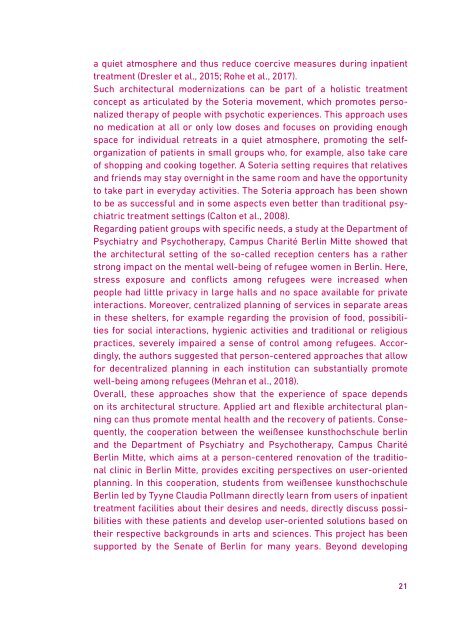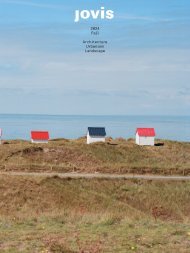visions4people – Artistic Research Meets Psychiatry
visions4people bietet einen kaleidoskopischen Überblick zur künstlerischen Forschung im Kontext psychiatrischer Lebenswelten und vermittelt deren besondere Herausforderungen. Wie können gestalterische Visionen und Interventionen aussehen, in denen Menschen im Mittelpunkt stehen? Tyyne Claudia Pollmann hat sich dieser Frage angenommen und sie im Rahmen einer Kooperation zwischen der Weißensee Kunsthochschule Berlin und der Klinik für Psychiatrie und Psychotherapie Charité Mitte gemeinsam mit Studierenden, Patient*innen und Mitarbeiter*innen der Psychiatrie untersucht. Wissenschaftliche und künstlerische Beiträge, Fotografien und polyphones Feldforschungsmaterial eröffnen den Leser*innen die facettenreichen Erfahrungen aus dieser Zusammenarbeit. Das Buch ist ein wertvoller Beitrag für Fachleute und Studierende aus den Disziplinen Kunst, Architektur, Gestaltung, Psychologie, Psychiatrie, Anthropologie und Soziologie, die Ähnliches planen – und eine Basis für neuartige kollaborative Projekte, in denen aus Betroffenen Beteiligte werden.
visions4people bietet einen kaleidoskopischen Überblick zur künstlerischen Forschung im Kontext psychiatrischer Lebenswelten und vermittelt deren besondere Herausforderungen. Wie können gestalterische Visionen und Interventionen aussehen, in denen Menschen im Mittelpunkt stehen? Tyyne Claudia Pollmann hat sich dieser Frage angenommen und sie im Rahmen einer Kooperation zwischen der Weißensee Kunsthochschule Berlin und der Klinik für Psychiatrie und Psychotherapie Charité Mitte gemeinsam mit Studierenden, Patient*innen und Mitarbeiter*innen der Psychiatrie untersucht.
Wissenschaftliche und künstlerische Beiträge, Fotografien und polyphones Feldforschungsmaterial eröffnen den Leser*innen die facettenreichen Erfahrungen aus dieser Zusammenarbeit. Das Buch ist ein wertvoller Beitrag für Fachleute und Studierende aus den Disziplinen Kunst, Architektur, Gestaltung, Psychologie, Psychiatrie, Anthropologie und Soziologie, die Ähnliches planen – und eine Basis für neuartige kollaborative Projekte, in denen aus Betroffenen Beteiligte werden.
Create successful ePaper yourself
Turn your PDF publications into a flip-book with our unique Google optimized e-Paper software.
a quiet atmosphere and thus reduce coercive measures during inpatient<br />
treatment (Dresler et al., 2015; Rohe et al., 2017).<br />
Such architectural modernizations can be part of a holistic treatment<br />
concept as articulated by the Soteria movement, which promotes personalized<br />
therapy of people with psychotic experiences. This approach uses<br />
no medication at all or only low doses and focuses on providing enough<br />
space for individual retreats in a quiet atmosphere, promoting the selforganization<br />
of patients in small groups who, for example, also take care<br />
of shopping and cooking together. A Soteria setting requires that relatives<br />
and friends may stay overnight in the same room and have the opportunity<br />
to take part in everyday activities. The Soteria approach has been shown<br />
to be as successful and in some aspects even better than traditional psychiatric<br />
treatment settings (Calton et al., 2008).<br />
Regarding patient groups with specific needs, a study at the Department of<br />
<strong>Psychiatry</strong> and Psychotherapy, Campus Charité Berlin Mitte showed that<br />
the architectural setting of the so-called reception centers has a rather<br />
strong impact on the mental well-being of refugee women in Berlin. Here,<br />
stress exposure and conflicts among refugees were increased when<br />
people had little privacy in large halls and no space available for private<br />
interactions. Moreover, centralized planning of services in separate areas<br />
in these shelters, for example regarding the provision of food, possibilities<br />
for social interactions, hygienic activities and traditional or religious<br />
practices, severely impaired a sense of control among refugees. Accordingly,<br />
the authors suggested that person-centered approaches that allow<br />
for decentralized planning in each institution can substantially promote<br />
well-being among refugees (Mehran et al., 2018).<br />
Overall, these approaches show that the experience of space depends<br />
on its architectural structure. Applied art and flexible architectural planning<br />
can thus promote mental health and the recovery of patients. Consequently,<br />
the cooperation between the weißensee kunsthochschule berlin<br />
and the Department of <strong>Psychiatry</strong> and Psychotherapy, Campus Charité<br />
Berlin Mitte, which aims at a person-centered renovation of the traditional<br />
clinic in Berlin Mitte, provides exciting perspectives on user-oriented<br />
planning. In this cooperation, students from weißensee kunsthochschule<br />
Berlin led by Tyyne Claudia Pollmann directly learn from users of inpatient<br />
treatment facilities about their desires and needs, directly discuss possibilities<br />
with these patients and develop user-oriented solutions based on<br />
their respective backgrounds in arts and sciences. This project has been<br />
supported by the Senate of Berlin for many years. Beyond developing<br />
21


















